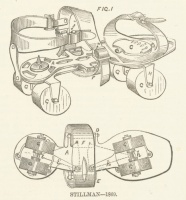With Britain facing a future of raised petrol prices it’s more than likely that the country and its drivers will turn to alternative and cheaper modes of transport. What better to meet their needs than the both efficient and charmingly old school roller skate?

It’s been 135 years this month since The Engineer reported on developments in the design of the roller skate, or the “parlour velocipede” as it was known. The invention was pioneered for German barmaids during the mid 1800’s in an attempt to serve punters more efficiently, due to the nature of the skate however women found they struggled to turn in a smooth curve when wearing them.
First patented in 1819 by French inventor M.Petitbled the early rollerskate was similar to the modern day inline skate. But, unlike the 20th century design, Petitbled’s wheels were sized with an equal diameter and made of metal, the weight making it virtually impossible for the skater to lift their foot.
Though the skate’s biggest design fault was Petitbled’s primitive choice of material, this was not the defect outlined by The Engineer in 1876.The magazine wrote that the ‘grave defect’ of the product was its ‘clumsy’ appearance, going on to say that ‘very few of the fairer sex would deign to encase their feet in such ugly replicates, lest it should be expected that their ankles were really the size of which they were made to appear’.
However, despite The Engineer’s scepticism American inventor James Plimpton was already hard at work on a skate design that eventually took the world by storm. Plimpton’s quad (four wheeled) skate design is still being used today, even by the ‘fairer sex’.




IEA report claims batteries are ‘changing the game’
The weight and bulk of static batteries, even domestic units, is immaterial. The IEA's trilemma is illustrated here:-...